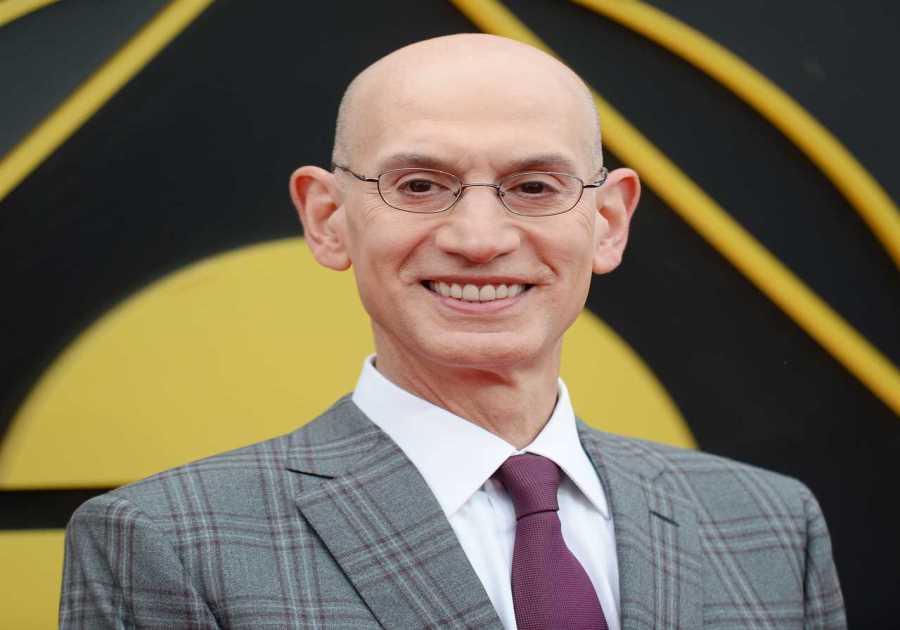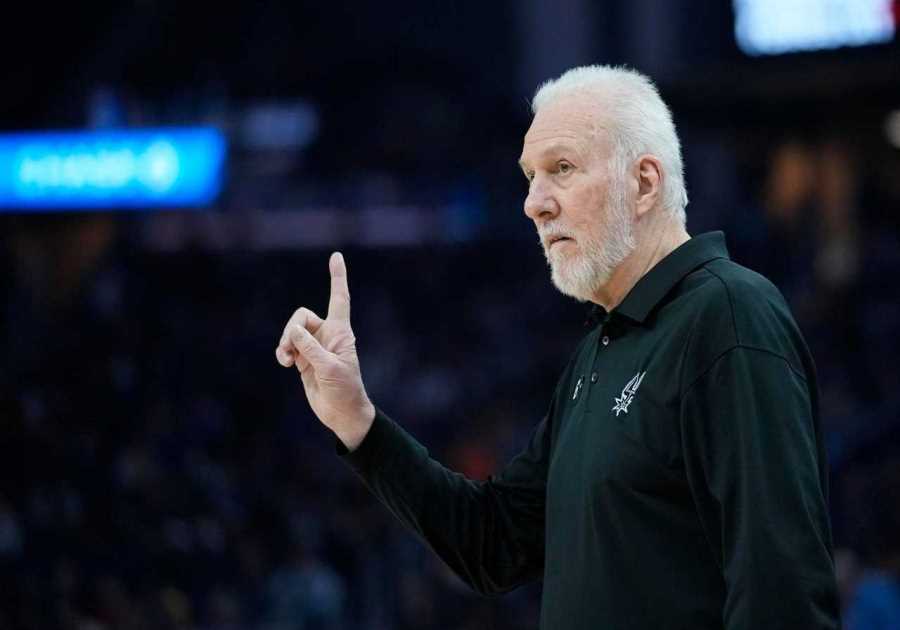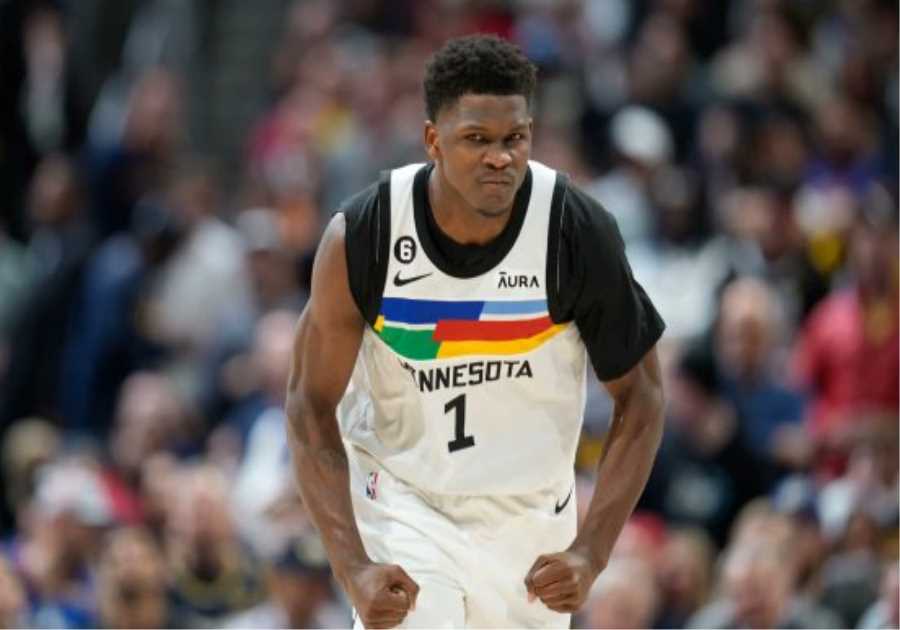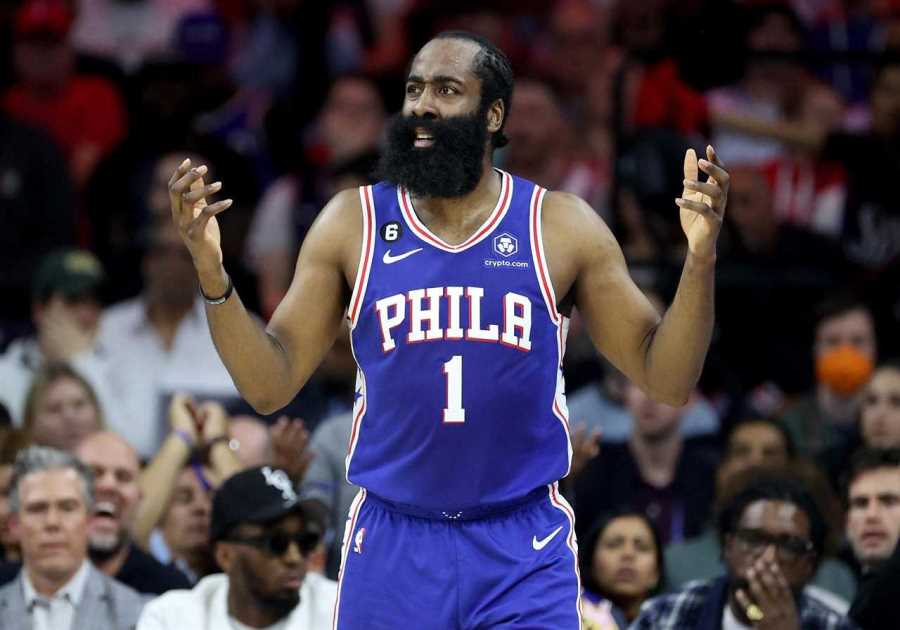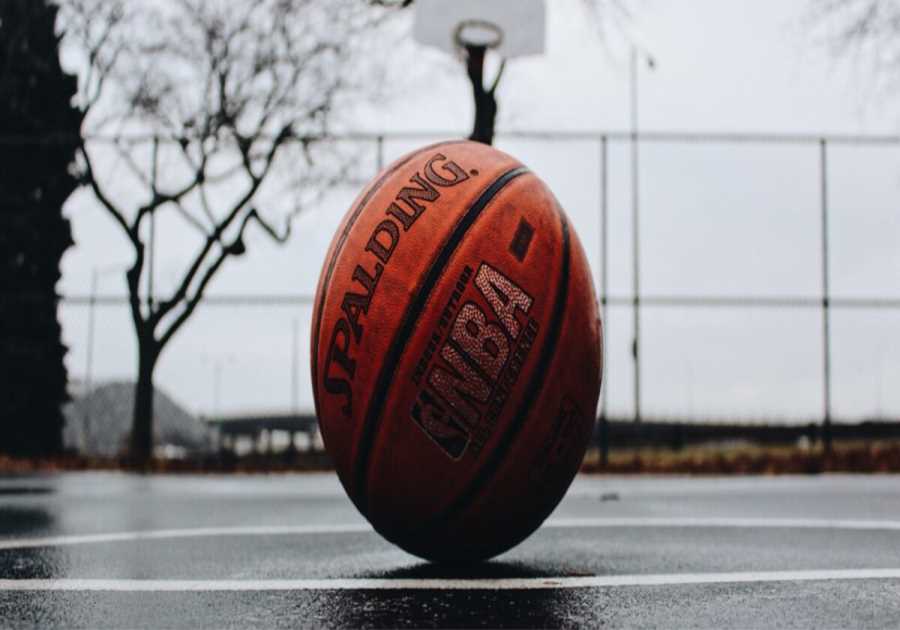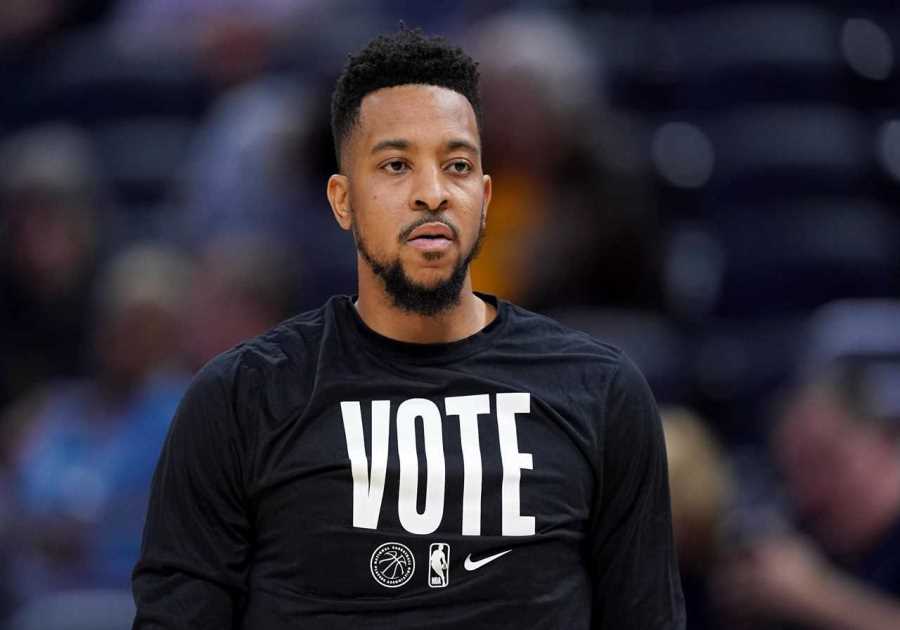
While the Denver Nuggets and Memphis Grizzlies have separated themselves at the top of the West standings, the rest of the conference is as condensed as ever. More than halfway through the season, only two games separate the West's 6-through-13 seeds.
That's eight teams, all within spitting distance of a locked-in playoff spot, and all at risk of tumbling out of the play-in picture entirely. At least one of them will finish above the play-in fray, and barring a collapse from one of the teams ahead of them, three will wind up on the outside looking in.
With that in mind, let's assess the current status and future prospects of all eight teams.
Golden State Warriors, 23-23How they got here: Lengthy injury absences for Steph Curry, Andrew Wiggins, and even Andre Iguodala, among others, haven't helped Golden State's title defense through the season's first half. Only the Bucks have lost more value to injury, according to Spotrac. But even when healthy, the Warriors haven't been sharp enough to repeat as champions.
Though their middling offense should stabilize now that they're healthier, the Warriors' defense remains a concern after largely the same roster managed a top-two mark last season. In addition, between a slew of injuries, Jordan Poole's regression, and the offseason departures of Gary Payton II, Otto Porter, and Damion Lee, the Dubs haven't enjoyed nearly the same depth they had a year ago. Golden State's bench ranks 28th in net rating after its reserves finished second in 2021-22, according to NBA.com.
Finally, the Warriors have been wretched away from the Bay Area, with only the league-worst Rockets posting a worse road record than Golden State's 6-18 mark.
Why they'll make the playoffs: Though their defense and depth are legitimate causes for concern, the defending champs falling short of the top 10 is unfathomable if the Warriors stay healthy. Case in point: In 306 minutes together, the team's best lineup of Curry, Wiggins, Draymond Green, Klay Thompson, and Kevon Looney has obliterated opponents by 19.3 points per 100 possessions, by far the top mark among the league's most-used lineup combinations. - Joseph Casciaro
LA Clippers, 24-24 Allen J. Schaben / Los Angeles Times / GettyHow they got here: Kawhi Leonard's return from an ACL tear hasn't exactly galvanized the Clippers the way so many optimistic prognosticators (guilty) anticipated coming into the season. Leonard's been in and out of the lineup, playing less than half of L.A.'s games so far, and he's only recently started to resemble himself on the court. Paul George has also missed time with injuries, and he and Leonard have shared the floor for a grand total of 400 minutes this season.
Without their two stars being consistently available, and with neither of them making jumpers or scoring one-on-one at peak levels, the Clippers' offense is in the toilet. Only the Rockets, Hornets, Spurs, and Pistons (the league's four worst teams overall) have scored less frequently on a per-possession basis. The Clippers have been an isolation-heavy team since Leonard and George arrived, but they used to at least be good at scoring out of those isos. This season they're finishing possessions with an iso at the league's seventh-highest rate, but they're scoring on those plays less efficiently than all but six teams, per NBA Advanced Stats.
The team's shoddy guard play is more glaring than ever, leading to a lack of dribble-drive rim pressure and playmaking limitations that result in missed reads, telegraphed passes, and sloppy turnovers. The Clippers' passes create the fewest potential assists of any NBA team. Their defense is fairly strong, but not strong enough to offset their offensive issues. And that doesn't seem likely to change, especially because some of the players they rely on to bolster that offense (like Norm Powell and, to a lesser extent, Luke Kennard) give plenty back at the other end.
The Clippers have lost nine of their last 12, they have the West's toughest remaining schedule, Leonard is still load-managing, and they're running out of time to establish any kind of on-court synergy for the stretch run.
Why they'll make the playoffs: If we were looking at this team in a vacuum, without any priors, their postseason prospects would look dim. But at the end of the day, as dispiriting as they've been to this point, it's still impossible to bet against the talent and the track records here.
Though his sporadic availability remains a point of frustration, Leonard rounding into form is a huge deal. Over his last six games, he's averaged 29.8 points, 6.3 rebounds, four assists, and two steals on 54/50/93 shooting, Peak Kawhi stuff. For the season, the Clippers have outscored opponents by six points per 100 possessions with him on the court, and by 9.3 points per 100 when he shares the floor with George.
Ty Lue may be struggling to establish an offensive identity (thanks in large part to the lack of night-to-night roster continuity), but he's a great macro-level tactician who tends to push the right buttons at the right times. With better health down the stretch, along with the possibility of deadline-day upgrades, this team should still be in the playoff mix when all's said and done. - Joe Wolfond
Utah Jazz, 24-25How they got here: The Jazz have fallen off their blistering early pace but continue to stave off the full-on tank that many expected to see after their offseason trades of Donovan Mitchell, Rudy Gobert, and Bojan Bogdanovic.
The reason they've stumbled is that their defense has predictably regressed after an unsustainably strong start, pulling them down to 26th in points allowed per possession. With flimsy point-of-attack defenders like Jordan Clarkson, Malik Beasley, and an aging Mike Conley struggling to contain dribble penetration, and minimal rim protection outside of rookie phenom Walker Kessler to clean up messes behind them, the Jazz allow more paint points than all but three teams. They also don't force turnovers and do a poor job closing possessions on their own glass.
The reason they're still in the thick of the playoff hunt: their offense remains absolutely elite. They rank fourth in the league thanks to a devastating drive-and-kick attack, a barrage of 3-balls, pristine ball movement, the league's fifth-highest offensive rebound rate, and the continued all-around scoring brilliance of Lauri Markkanen - whose 66.7% true shooting mark puts him behind only Nikola Jokic, Kevin Durant, and Domantas Sabonis among players with usage rates above 20%.
The Jazz have also played a preposterous number of close games - 33 of their 49 have included "clutch" time, most in the NBA - and their 14-19 record in those games has perhaps obscured their true talent level. Their plus-1.2 net rating is the best among this group of teams, and ranks 10th in the league.
Why they might miss the play-in: This simply comes down to desire - not on the part of the players, but the front office.
If this group stays together, Utah will have a strong chance to make the play-in and even advance to the playoffs proper. But Danny Ainge and Co. clearly have a longer-term vision here, and it's unclear how much they'd value an abbreviated postseason appearance compared to recouping assets for some of their vets and then adding a 2023 lottery pick to the mix.
At this point, it seems likely that one or more of Conley, Clarkson, Beasley, and Kelly Olynyk will be moved before the Feb. 9 trade deadline. That alone might not derail the Jazz, but it's easy to see them taking their foot off the gas in other ways, with built-in rest days for their best players and more minutes for developing prospects down the stretch. With every other team in the hunt (save OKC) having a much stronger incentive to push for a spot, Utah feels like the safest bet to miss out. - Wolfond
Minnesota Timberwolves, 23-24 David Berding / Getty ImagesTheir offseason megatrade for Gobert has been a staggering disappointment so far. Gobert hasn't been quite the pick-and-roll corralling, paint-protecting force he's been in the past, which makes his stone-handed clunkiness on offense all the more frustrating. He hasn't clicked offensively with either of the Wolves' starting guards, and he struggled to mesh defensively with frontcourt mate Karl-Anthony Towns before Towns went down with a calf injury that's sidelined him for seven weeks and counting.
The Wolves are light on scorers who can defend, and defenders who can shoot - a problem exemplified by the contrasting limitations of their two high-profile bigs. Their offense has been 11.9 points per 100 possessions worse with Gobert on the floor, but their defense has been a disaster without him, especially with Towns on the floor. After squeezing the most out of a flawed roster last season, head coach Chris Finch has struggled to craft an optimal scheme at either end this year. Minnesota is losing the 3-point battle by more than six points a night. Even with Gobert in the fold, the team somehow still can't grab a defensive rebound to save its life.
Minnesota's actually done a good job weathering Towns' absence, going 13-13 without him. Anthony Edwards has stepped up and taken the reins of the offense with gusto. Jaden McDaniels continues to be the team's defensive glue, whether he's guarding the point of attack or providing weak-side help. Kyle Anderson has finally found his niche as an on-ball creator. Backup center Naz Reid has chipped in solid minutes off the bench (and lately as a starter now that Gobert is also hurt).
But that's sort of been the story of the Wolves' season so far; an injury seems to crop up every time they gather momentum or threaten to build a semblance of cohesion. It's all felt like one big game of whack-a-mole. Will Towns' eventual return set them on the right track, or force them into another set of adjustments that take weeks to iron out?
Why they'll make the play-in: As inconsistent as they've been, as ugly as it's looked at times, there's still a good team in here somewhere. They need more reps with everyone healthy, but Edwards coming alive is a huge development, and Gobert had started to look better before his injury. At full strength, this is a team with a deep rotation and a lot of offensive firepower.
Things may not fully come together for them this season, and the Gobert trade will probably continue to be one they'd like to have back, but hosting a play-in game still feels like a reasonable expectation. - Wolfond
Oklahoma City Thunder, 22-24How they got here: On paper, this season looked like another rebuilding campaign for the future-minded club, especially with a pair of generational talents atop the incoming draft class. Instead, OKC is taking the league by storm with a young group that's coalescing at both ends of the floor. The Thunder are 11-6 over their last 17 games, with nine of those wins coming over teams currently in the play-in picture (including juggernauts Boston, Memphis, and Philadelphia). They sit just a game out of a guaranteed playoff spot.
The Thunder's defense has been the biggest driver of their success, as it's been a top-10 unit for most of the season. Without a dominant rim-protector, they get by on swarming ball pressure, aggressive digs on drives, and frenetic help-and-recover rotations that rely on their collective speed and length. As a result of that scheme, they give up a lot of high-value shots, foul a ton, and surrender plenty of offensive rebounds. But so far they're making the high-wire act work, mainly by generating a ton of turnovers and effectively protecting the rim by committee.
Their offense suffers from a lack of outside shooting and roll gravity, but they make up for it with the league's most relentless driving attack. The Thunder average 9.3 more drives per game than any other team, and the gap between them and the second-place Knicks in that category is equivalent to the gap between the Knicks and the 18th-ranked Raptors. That charge is obviously spearheaded by Shai Gilgeous-Alexander, who has ascended to full-blown superstardom and leads the league in drives for the third straight season. But it's really been a team-wide imperative, with guys like Lu Dort, the ascendent Josh Giddey, and impressive rookie Jalen Williams joining the effort to assault the basket at every opportunity.
The team's 3-point shooting has also improbably ticked up to league average. Isaiah Joe's long-range bombing has been a welcome addition, Dort and Giddey have been shooting the ball much better of late, Kenrich Williams is always reliable off the catch, and Mike Muscala is a passable pick-and-pop weapon. During this impressive 17-game stretch, OKC ranks ninth in offensive efficiency.
Why they might miss the play-in: The Thunder are like the inverse of the Clippers, in that you'd probably expect them to keep things rolling in a positive direction if you didn't have any preconceptions about them. This team's indicators are generally very encouraging (they have the second-best net rating in this group behind Utah), but it's hard to trust them moving forward without knowing what the organizational mandate for the rest of the season is going to be.
They don't really have veterans to sell off the way the Jazz do (especially because they seem set on keeping Kenrich Williams), so the roster might not wind up looking much different than it looks now. But they're also probably playing slightly above their heads at both ends, and it feels unlikely they'll cash in any of their meaningful draft assets to make a short-term deadline upgrade. They're also not above resting key players with phantom injuries down the stretch if they deem draft positioning more beneficial than high-leverage reps for their young players.
Contrast that with the desperation of the other teams fighting for those last play-in spots, and you can imagine them bowing out of the race, even though they have the talent and ferocity to stay in it to the end. - Wolfond
Phoenix Suns, 22-24 Steph Chambers / Getty ImagesHow they got here: After seemingly rising above a bevy of offseason dysfunction to rip off 16 wins in their first 23 games, the Suns' meteoric descent back to earth began with a Dec. 5 loss in Dallas (to the same Mavs team that humiliated them in Game 7 last May). Phoenix has lost 17 of 23 since then, with Devin Booker's absence the primary culprit.
Booker has only played in essentially five of those 23 games - he logged under five minutes in a Christmas loss to Denver before re-aggravating a groin injury - and the Suns look lost without him. Chris Paul, who missed 14 games earlier this season due to a heel injury, has been sidelined by a hip issue for the last couple of weeks, but is no longer equipped to be a top team's lead guard. Paul, like the Suns, needs Booker.
Meanwhile, Deandre Ayton's play has been as inconsistent as ever (though a lack of competent guard play doesn't help), and veteran forward Jae Crowder continues to sit out while the Suns explore trading him. Perhaps the only bright spot so far has been the play of Mikal Bridges, who's successfully taken on more self-creation responsibilities with Booker, Paul, and even Cam Payne sidelined.
Why they'll make the playoffs: Booker and deadline reinforcements.
Booker's out for at least another week. However, assuming he can return before the season's been completely derailed, it's important to remember that Phoenix is a very good team with their MVP candidate on the floor (plus-6.9 points per 100 possessions, according to NBA Wowy). In addition, the Suns finally have starter Cam Johnson back after the young forward missed two-plus months due to a torn meniscus in his right knee.
If their best players stay healthy, the Suns will be fine. And it's reasonable to figure the front office will add upgrades before the deadline, given Phoenix's limited window to win with Paul in the fold. Between Crowder, young talent under long-term control, and all their own draft picks, the Suns have the means to make a bold move. Complicating matters is the fact suspended owner Robert Sarver still has final say on any trades worth at least $10 million, unless new owner Mat Ishbia can complete his takeover from Sarver before the deadline. - Casciaro
Portland Trail Blazers, 21-24 How they got here: The new-look Blazers got off to great start, and the fact Portland went a respectable 5-7 in the 12 games Damian Lillard missed over the first six weeks seemed like a positive indicator, but a hot defensive start now looks like a mirage.
Despite the additions of Jerami Grant and Gary Payton II (the latter made his Blazers debut only a couple of weeks ago) to a frontcourt already consisting of Josh Hart, Jusuf Nurkic, and Justise Winslow (currently sidelined), Portland ranks 21st in defensive efficiency. That's an improvement over last year's 29th-ranked D, but still disappointing given the length and versatility at head coach Chauncey Billups' disposal.
The Blazers' continued defensive struggles this season - despite the revamped roster - are another reminder that there's only so much defensive upside a team and coach can tap into when its backcourt consists of Lillard and Anfernee Simons. Lillard has been his old, phenomenal self on the offensive end, and Simons continues to admirably blend volume and efficiency, but the point-of-attack defense has been a predictable disaster.
Why they'll make the play-in: Their defensive ceiling caps the Blazers' overall upside, but we're talking about whether they can finish top 10 in the conference, not contend for a championship. With an explosive offensive backcourt that brings boatloads of scoring, shot-creation, range, and playmaking, and a bevy of defensive problem-solvers behind it, Portland should have enough to at least continue hovering around .500, and that should get it at least one play-in game.
There might also be some hope for the defense, as the Blazers will eventually welcome back small-ball center Winslow, who's yet to play a single game with Payton. - Casciaro
L.A. Lakers, 21-25 Andrew D. Bernstein / National Basketball Association / GettyHow they got here: An incompetent front office constructed an ill-fitting roster that still didn't boast enough shooting or secondary creation around LeBron James and Anthony Davis, and Davis got hurt again.
Davis was playing possibly the best basketball of his career before a right foot injury became the latest in an impossibly long list of ailments to shelve the big man. Nevertheless, the Lakers still managed a losing record (8-11) in 19 games Davis and James played together, mustering a pedestrian net rating of plus-2.1 per 100 possessions in 484 minutes the superstars shared the court.
Recent injuries to Lonnie Walker IV and Austin Reaves have only exacerbated the Lakers' lack of depth.
Why they could make the play-in: LeBron. Impossible as it may seem given his age, the unprecedented number of NBA miles on his body, and the lack of talent around him with Davis (and others) sidelined, James has taken his game to another level over the last few weeks.
In a compact but uninspiring West, if the Lakers can get Davis back while James continues to play at this level, L.A. has to be considered a threat to at least make the playoffs. The Lakers are only two games behind the conference's top six, after all.
Then again, the Lakers will also need Davis and James to stay healthy, and they could still use a ton of help; help that may never arrive given Jeanie Buss' reported reluctance to trade the little draft capital L.A. has left. - Casciaro
Copyright © 2023 Score Media Ventures Inc. All rights reserved. Certain content reproduced under license.
Joseph Casciaro, Joe Wolfond
https://www.thescore.com/nba/news/2551076
By: Joseph Casciaro, Joe Wolfond
Title: Sorting out the muddled morass in the West
Sourced From: www.thescore.com/nba/news/2551076
Published Date: 01-21-2023
Frequently Asked Questions
Who was the first to score a basket in the NBA?
Ossie Schetzman, an American professional basketball athlete, was the first to score a basket in the Basketball Association of America. The NBA would become the National Basketball Association later. The Toronto Huskies played the New York Knickerbockers on November 1, 1946. Schectman's historic first basket was the opening of the inaugural season for BAA.
How much does the NBA pay a ref?
Referees of the National Basketball Association receive competitive salaries for their officiating tasks. Average NBA referees earn between $150,000- $550,000 annually. This scale of pay can vary depending on the experience of referees. More experienced referees will earn higher salaries. Referees who work in the playoffs and finals are paid higher than those who have additional roles such as training refs or working at the video review centre. A few NBA refs also earn royalties and endorsements for their work on television or other media outlets. Overall, being a NBA referee could be a highly lucrative job that can generate steady income for those who are willing to do the hard work.
The salary is not the only benefit for NBA referees. They also get health insurance and retirement plans. Referees have a healthier lifestyle because they make crucial decisions that can change the outcome of games. Referees can also receive subsidised accommodations, meals and travel costs to away games. This is a great way to have peace of mind while referees work hard on the court.
NBA referees receive a decent wage for their hardwork and dedication. This is especially true when they are responsible to enforce the rules in one of the most popular sports in world. The job can be demanding, but it is a rewarding experience that provides referees with an opportunity to make a difference in basketball.
Which basketball player is the best?
It is difficult to answer this question because there are so many great players and everyone has their opinion. Some of the most prominent contenders for this title include Kobe Bryant and LeBron James as well as Kareem AbdulJabbar, Magic Johnson, Larry Bird, and LeBron James. Each of these legends made a significant impact on basketball and earned their place within basketball history. Furthermore, these players have each had unique styles of play that have been admired by millions worldwide. Therefore, it is impossible to definitively answer this question as everyone has their own opinion on who the best player of all time is. We can all agree that these six exceptional players must be on any list of the greatest players of our time.
Most people agree that Michael Jordan was the greatest basketball star of all time. He was born in Wilmington on February 17, 1963.
Jordan started his professional basketball career in 1984 with the Chicago Bulls and quickly became one of the most successful and famous players of his time. Jordan was a six time NBA champion, six -time NBA finals M MVP, five -time NBA regular season MVP. He also served as a 10-time NBA score leader, 10-time NBA second team, nine times NBA all-defensive team MVP, and three times NBA steals leader.
Jordan is also a twotime Olympic gold medalist. He was inducted into Basketball Hall of Fame 2009 Jordan's remarkable ability to score from any position on the court, make plays and lead the team is what will be remembered. He will forever remain an inspiration to millions worldwide due to his never-ending drive and ambition.
Jordan's legacy will live on forever; he is the undisputed greatest basketball player of all time. Jordan is the only player who can match his level of accomplishment. He will be forever remembered as one among the greatest sports figures ever. Michael Jordan is undoubtedly the greatest athlete of all time. His remarkable career and achievements will be remembered forever. He was, still is, and will forever be "The Goalkeeper," the legendary Michael Jordan.
What is a NBA-specific hybrid contract?
A hybrid contract allows the NBA to offer players higher salaries that they wouldn't otherwise be able. These contracts allow for a portion of the salary to be added to the team's cap and the remainder is paid directly as a bonus to the player. This allows teams to offer higher salaries while still complying with league salary restrictions. Because players can earn significantly more than they would otherwise, it gives them incentive to sign for specific teams.
When did Bill Russell die?
"The great ones are the ones who play when it matters most." -Bill Russell
A legend is a person who lives on forever. Legends die when they stop playing.
However, those moments gave us a glimpse of the greatest basketball players.
Russell was born February 1934, and he died July 31, 2022. He won 11 championships with the Boston Celtics in only 13 seasons.
Bill Russell is the recipient of five MVP awards as well as 12 All-Star selections. His passion for winning made him a great leader and defender.
He transformed the Celtics from a mediocre team to one of the greatest dynasties in sports history. He was unselfish and a strong competitor who encouraged his teammates to achieve their full potential.
Russell has inspired generations upon generations of coaches, players, and fans. His legacy is irreplaceable.
Bill Russell, Rest in Peace. We will forever remember you as one of basketball's greatest players.
What does NBA refer to as "waived"?
The NBA refers to "waived", which means that a team has released a player. This can be done for various reasons, including salary cap reasons, personal issues, or disciplinary action. If a player is deemed to be unrestricted and free to sign with any team within the league, they can become a restricted free agent. The player is not eligible to participate in the playoffs if they were waived after March 1, 2001.
How much do NBA players make?
The NBA's average salary was $7.3million during the 2021-2022 season. This is based upon the $134 million salary cap that was established for this season. However, the salaries of individual players can vary depending upon their experiences and achievements.
Kevin Durant, LeBron James, and Kevin Durant are superstars that can earn upwards of $40,000,000 per year. Newcomers may only be able to make the minimum $898,310 salary. Other veteran players may also be eligible, depending upon their years of experience, for mid-level exemption salaries. These can range from $4.76million up to $9.258million. A player may be eligible to receive bonuses or other incentives depending on how they perform or the success of their team.
Statistics
- The opening game of the 2020 Finals between the Los Angeles Lakers and Miami Heat brought in only 7.41 million viewers to ABC, according to The Hollywood Reporter. (en.wikipedia.org)
- Williams would 'likely' accept a deal worth $14-15M/year; Celtics are 'unlikely' to offer such a deal (HoopsHype) (bleacherreport.com)
- Meanwhile, the opening night rosters include a record-setting 234 players with some G League experience, according to the NBA ( Twitter link ). (hoopsrumors.com)
- Williams would 'likely' accept a deal worth $14-15M/year; Celtics are 'unlikely' to offer such a deal (HoopsHype) (bleacherreport.com)
- "NBA first-round ratings drop 27 percent, 40 percent since 2017–18". (en.wikipedia.org)
External Links
sbnation.com
bleacherreport.com
- Which NBA Teams Will Join the Victor Wembanyama Tankathon?
- Latest NBA Intel: Sources Say Zach LaVine Will Sign with Chicago Bulls
sports.yahoo.com
basketball-reference.com
- Thomas Bryant Stats, Height, Weight, Position, Draft Status and more | Basketball-Reference.com
- Dennis Schroder Stats, Height, Weight, Position, Draft Status and more | Basketball-Reference.com
How To
What is the best way to get drafted into the NBA?
Two ways to become an NBA player are through college or high school.
NCAA schools include Duke University, North Carolina State University and the University of Kentucky for college students. These schools offer four-years of education and training. Players develop ball handling, shooting, and rebounding skills during this period. They learn how the offense and defense work together. They also develop the mental skills necessary to become a professional runner.
High school players attend prep schools outside of their home states. These schools give athletes individual attention and develop talent. Players are taught academics, character development, and sportsmanship.
Both types of players must pass the same physical tests before they are allowed to enter the draft. The test consists of running 40 yards, jumping over a 5'6" box, standing on one leg, and throwing a football through a tire.
After passing these tests, players can be invited to workout with different NBA teams. They are evaluated based on their height and weight as well as their speed.
Teams also look at their previous experience. For instance, if a player has played AAU basketball, he will likely receive preferential treatment.
Sometimes, players considered too small to be professional athletes are called "one and done" prospects. These players are usually selected in the second round.
Some players choose to skip college and go straight to the NBA. These players are known to be "prospects". Prospects don't have to wait to declare themselves eligible to draft.
They can ask for an exemption to allow them to participate in the draft early. If a prospect does so, he will be able to compete against other prospects during the pre-draft process.
Summer leagues are a great way for prospects to increase their chances of being selected. Summer league games are held in July and August.
Scouts have the chance to see players in action at these events without worrying about injury.
The NBA Draft takes place in June. It's when the 30 NBA teams evaluate all the top prospects. Each team has a specific number of picks for each round.
In this example, the 15th overall pick is the first pick of the first round. The 60th selection is in the third round.
After the draft, teams make trades in order to fill their rosters. Some teams even hold mini-camp tryouts inviting potential draftees to train with them.
It's exciting to draft day! What happens next?
Once the draft starts, you don't have to wait for your name in the call. Each NBA team picks a player from the pool.
After a player is selected by a team, it sends him an agreement that details his salary, playing time and benefits. He becomes an employee of the company.
He also gets a jersey with the name of his choice on the back, and a new uniform with his nickname.
He signs the contract. That is when he officially joins NBA.

